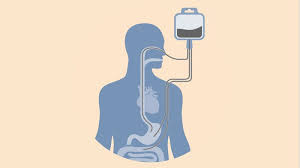
Intestinal nutrition
Intestinal feeding may mean feeding through the mouth or a tube that connects directly to the stomach or small intestine. In the medical setting, the term intestinal nutrition often means tube feeding. Intestinal nutrition usually occurs in an illness or injury that prevents eating a regular diet through the mouth. However, the digestive system is still able to function.
Uses of Intral Nutrition
• Stroke, which may impair the ability to swallow
• Cancer, which can cause fatigue, nausea, and vomiting that make it difficult to eat
• A vital illness or injury, which reduces energy or reduces the ability to crave
• Lack of growth or inability to eat in young children or infants
• A serious illness, which puts the body under stress and makes it difficult to get enough nutrients
• Nervous or motor disorders increase the number of calories needed while making food more difficult
• In dysfunction or gastrointestinal disease intravenous (injectable) feeding may be recommended instead.
Types of intestinal nutrition
According to the American College of Gastroenterology, there are six major types of feeding tubes. These tubes may have other subtypes, depending on where they end in the stomach or intestines. The main types of intestinal feeding tubes are:
The nasogastric tube (NGT) starts at the nose and ends at the stomach.
The fallopian tube (OGT) starts in the mouth and ends in the stomach.
The naso ventricular tube begins in the nose and ends in the intestine (includes a variety of nasogastric and nasoduodenal tubes)
The urethral tube starts in the mouth and ends in the intestines.
The gastrostomy tube is inserted directly into the stomach through the skin of the abdomen (various types including PEG, PRG, and button tubes)
• The jejunostomy tube is inserted directly into the intestines through the skin of the abdomen (subtypes including PEJ and PR tubes)
Nasal or gastric tube placement, while uncomfortable, is quite simple and painless and does not require anesthesia. Typically, a nurse measures the length of the tube, lubricates the tip, places the tube in your nose or mouth, and moves until it is in your stomach. The tube is usually secured with a soft band on your skin. Also, it can be used immediately after confirmation.
Unlike tubes that end in the stomach, tubes that end in the intestine (naso enteric, esoteric, and urethral) often require endoscopy.
Gastrostomy or jejunostomy tubing is a procedure that may require sedation or sometimes general anesthesia.
Possible side effects of intestinal nutrition
Complications of feeding through the intestinal tract:
• Food enters the lungs
• Constipation
• Diarrhea
• Improper absorption of nutrients
• Nausea
• Vomit
• Dehydration
• Electrolyte abnormalities
• Lack of blood sugar
• Deficiency of vitamins and minerals
• Decreased liver protein
Complications of malnutrition through the nasal passages (nasogastric or nasoenteric tubes) include:
• Irritation of the nose or throat
• Acute sinus infections
• Laryngeal or esophageal ulcer
Also, entered feeding tubes through the skin of the abdominal wall, such as gastrostomy or jejunostomy tubes, can become blocked or displaced, and lead to wound infection. In general, however, there are usually no long-term side effects of intestinal nutrition. When you resume your diet, you may experience gastrointestinal upset as your body becomes accustomed to solid foods.




